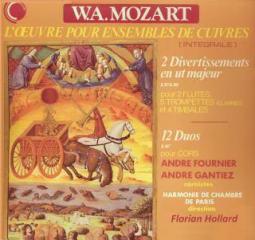Mozart: Two Divertissements - Twelve Duos for Horn (Florian Hollard)
Mozart: Two Divertissements - Twelve Duos for Horn (Florian Hollard)

Divertimento No.5 in C Major K.187 1. Allegro moderatio 2. Menuetto. 3. Adagio. 4. Menuetto. 5. Allegro. 6. Allegro moderato. 7. Allegro molto. 8. Allegro non troppo. Divertimento No.6 in C Major K.188 1. Andante 2. Allegro 3. Menuetto 4. Andante 5. Menuetto 6. Gavotte Harmonie de Chambre de Paris Florian Hollard - director 12 Duos for Horns K.487 1.Allegro 2.Menuetto: Allegretto 3.Andante 4.Polonaise 5.Larghetto 6.Menuetto 7.Adagio 8.Allegro 9.Menuetto 10.Andante 11.Menuetto 12.Allegro Andre Fournier and Andre Gantiez – horns
The seventeen works range from K.113 to K.334 and span the years 1771 to 1779. These short, sparkling, brilliant pieces were created for a typical ensemble of 6 to 14 players for strings, clarinet, bassoon, oboe, horns, flute, trumpets, and drums. Often recorded and performed, the 17 divertimenti are increasingly popular with music lovers and essential for Mozart enthusiasts.--- abebooks.co.uk
Mozart probably composed the Duos for Horn, K. 487, for players within the Jacquin family circle of friends, one of whom was virtuoso hornist Joseph Leutgeb (1732-1811), whom Mozart knew in Salzburg. Leutgeb, the inspiration for Mozart's horn concertos, had been a friend of the Mozart family in Salzburg before moving to Vienna to take over a cheesemonger's shop. After relocating to Vienna in 1781, Mozart renewed his contact with Leutgeb.
Mozart completed the Horn Duos on July 27, 1786, "untern Kegelscheiben" (while playing nine-pins). Legend has it that Mozart composed the Clarinet Trio under the same conditions, but this cannot be substantiated as it can for the Horn Duos. Leutgeb's technique must have been excellent, for the horn parts, especially the first horn, in no way hover around the intervals easily performed on the instrument. Leutgeb's use of his hand in the bell (an innovative technique at the time) enabled him to produce all the pitches of a given scale, as well as a few altered tones, with apparent ease. Thus, the Duos of K. 487 are melodically inventive, with a charm and grace we do not hear in orchestral or wind ensemble horn parts. Few of the individual pieces are more than thirty measures in length, exhibiting a compactness and economy that are the mark of a mature and experienced composer.
A few of the Duos are representative of the set. An Andante in C major shows the typical distribution of material, with the first horn carrying the bulk of the melodic presentation, the second horn providing counterpoint and harmony. Occasionally, the two instruments play in thirds. The piece is in two sections, the first of which is a twelve-measure melody that modulates to the dominant (G major) and is repeated. The second half opens with eight measures of new material then moves to a varied version of the last eight measures of the first theme before closing. Thus, the movement is rounded binary but with some variation. Many of the Duos follow this pattern.
The C major Allegro is also rounded binary, but only one measure of the returning first phrase is recognizable; the rest of the melody is altered fundamentally to create a cadence on the tonic instead of the dominant. Also, the hierarchy of the horn parts is upset. The first horn part is only occasionally more interesting than the second, and in the canonic opening of the second half, the parts are equal.
Chromatic melodic passages in the second part of the ensuing Menuetto attest to the technique of Mozart's horn-playing friends. As one would expect, the form of the Menuetto is rounded binary, but again Mozart alters the "rounding" segment to the point that only a couple of measures remind us of the first phrase. A salient feature of the Trio is Mozart's insistence on a diminished fifth that does not resolve until the end. Even then, the harmony is designed not to sound like a close, but to anticipate the return to the Menuetto. ---John Palmer, Rovi
download (mp3 @320 kbs):
uploaded yandex 4shared mega mediafire zalivalka cloudmailru oboom uplea
Last Updated (Saturday, 12 December 2015 17:04)








